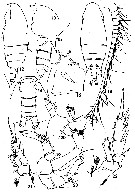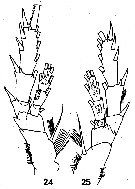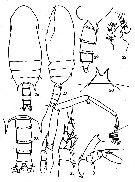|
|
 |
|
Calanoida ( Order ) |
|
|
|
Clausocalanoidea ( Superfamily ) |
|
|
|
Aetideidae ( Family ) |
|
|
|
Bradyidius ( Genus ) |
|
|
| |
Bradyidius subarmatus Markhaseva, 1993 (F,M) | |
| | | | | | | Ref.: | | | Markhaseva, 1993 a (p.50, figs.F,M); 1996 (p.81, fgs.F,M) |  issued from : E.L. Markhaseva in Zoosyst. Rossica, 1993, 2 (1). [p.49, Figs.11-23]. Female (from Norway): 11-12, habitus (dorsal and lateral, respectively); 13, forehead (lateral); 14-15, posterior of prosome (dorsal and lateral, respectively); 16, genital segment (lateral); 17, rostrum; 18, A1; 19, A2; 20, Md (mandibular palp); 21, P1; 22, P2; 23, exopod of A2. Holotype: 11-22 from Raunefjorden (South of Bergen); paratype: 23 from Langesundsfjorden (Norway). Nota : Cephalothorax 4 times longer than urosome. Rostral rami divergent. Points of thoracic segment 5 posterior corners extending to posterior border of genital segment (dorsal and lateral view). Spematheca elongate, oval. Exopodite 1 of A2 with 1 seta, exopodite 2 with 3 setae. Endopodite 1 of Md with 2 setae (sometimes with a small 3rd seta), endopodite 2 with 9 long terminal and 1 posterior short . Posterior surface of Mx1 gnathobase with 4 setae, endopodite with 16 setae. External spine on exopodite 1 of P1 long, almost reaching the middle of exopodite 2 spine. Endopod of P2-P4 with minute surface spinules.
|
 issued from : E.L. Markhaseva in Zoosyst. Rossica, 1993, 2 (1). [p.450, Figs.24-25]. Female (from Raunefjorden): 24, P3; 25, P4. Nota : Coxopodite of P4 with thickened hairs along internal border. Terminal spines of exopodite 3 of P3-P4 with 20 and 23 denticles, respectively.
|
 issued from : E.L. Markhaseva in Zoosyst. Rossica, 1993, 2 (1). [p.51, Figs.26-34]. Male (from Langesundsfjorden, Norway): 26-27, habitus (dorsal and lateral, respectively); 28-29, posterior of prosome and urosome (dorsal and lateral, respectively); 30, rostrum; 31, A2; 32, Mx1; 33, P1; 34, P5. Nota : Cephalothorax about 3.3 times longer than urosome. Rostral rami divergent. A1 reaching posterior border of urosomal segment 4. Points of posterior thoracic segment 5 corners exceeding posterior border of genital segment, covering the proximal third of urosomal segment 2. Oral parts rudimental, setation partly reduced. Md palp base with 1 seta, endopodite 1 without setae, endopodite 2 with 8 setae. protopodite of Mxp without setae, endopodite 1 with 3 medial setae. External spines on exopodite 1-exopodite 3 of P1 shorter than in female. P2-P4 of the same structure as in female, but P4 coxopodite without hairs along internal border. P5 very similar to that of B. armatus, but distal (3rd) segment of right P5 with 2 terminal and 1 external spines.
|
 Bradyidius subarmatus Bradyidius subarmatus female: 1 - Rostrum with divergent rami. 2 - Points of last thoracic segment exceeding posterior border of genital segment. Exopodal segment 2 of A2 with 3 setae. Endopodal segment 1 of P1 with external spine exceeding the base of external spine of segment 2. 3 - Points of last thoracic segment straight. 4 - Genital segment 1.09 times wider than long. Exopodal segment 1 of A2 with 1 small seta. Spermatheca elonate-oval.
|
 Bradyidius subarmatus Bradyidius subarmatus male: 1 - P5 uniramous. 2 - Right P5 nearly 3 times shorter than left. 3 - Distal segment of right P5 with 2 terminal small spines.
| | | | | NZ: | 1 | | |
|
Distribution map of Bradyidius subarmatus by geographical zones
|
| | | | Loc: | | | Norway (Raunefjord, Langesudsfjord, Fanafjord).
Type locality: Raunefjord (Norwegian coast). | | | | N: | 2 | | | | Lg.: | | | (37) F: 2,8-2,6; M: 2; {F: 2,60-2,80; M: 2,00} | | | | Rem.: | hyperbenthic (depth 140 m).
According to Markhaseva (1993, p.50) this species is distinguished from the closely related B. armatus by the width of genital segment, equipment of A2 exopodite 1, and shape of spermatheca. | | | Last update : 30/12/2014 | |
|
|
 Any use of this site for a publication will be mentioned with the following reference : Any use of this site for a publication will be mentioned with the following reference :
Razouls C., Desreumaux N., Kouwenberg J. and de Bovée F., 2005-2025. - Biodiversity of Marine Planktonic Copepods (morphology, geographical distribution and biological data). Sorbonne University, CNRS. Available at http://copepodes.obs-banyuls.fr/en [Accessed December 04, 2025] © copyright 2005-2025 Sorbonne University, CNRS
|
|
 |
 |






